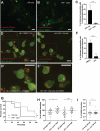The autophagic response to Staphylococcus aureus provides an intracellular niche in neutrophils
- PMID: 32174246
- PMCID: PMC8078660
- DOI: 10.1080/15548627.2020.1739443
The autophagic response to Staphylococcus aureus provides an intracellular niche in neutrophils
Abstract
Staphylococcus aureus is a major human pathogen causing multiple pathologies, from cutaneous lesions to life-threatening sepsis. Although neutrophils contribute to immunity against S. aureus, multiple lines of evidence suggest that these phagocytes can provide an intracellular niche for staphylococcal dissemination. However, the mechanism of neutrophil subversion by intracellular S. aureus remains unknown. Targeting of intracellular pathogens by macroautophagy/autophagy is recognized as an important component of host innate immunity, but whether autophagy is beneficial or detrimental to S. aureus-infected hosts remains controversial. Here, using larval zebrafish, we showed that the autophagy marker Lc3 rapidly decorates S. aureus following engulfment by macrophages and neutrophils. Upon phagocytosis by neutrophils, Lc3-positive, non-acidified spacious phagosomes are formed. This response is dependent on phagocyte NADPH oxidase as both cyba/p22phox knockdown and diphenyleneiodonium (DPI) treatment inhibited Lc3 decoration of phagosomes. Importantly, NADPH oxidase inhibition diverted neutrophil S. aureus processing into tight acidified vesicles, which resulted in increased host resistance to the infection. Some intracellular bacteria within neutrophils were also tagged by Sqstm1/p62-GFP fusion protein and loss of Sqstm1 impaired host defense. Together, we have shown that intracellular handling of S. aureus by neutrophils is best explained by Lc3-associated phagocytosis (LAP), which appears to provide an intracellular niche for bacterial pathogenesis, while the selective autophagy receptor Sqstm1 is host-protective. The antagonistic roles of LAP and Sqstm1-mediated pathways in S. aureus-infected neutrophils may explain the conflicting reports relating to anti-staphylococcal autophagy and provide new insights for therapeutic strategies against antimicrobial-resistant Staphylococci.Abbreviations: ATG: autophagy related; CFU: colony-forming units; CMV: cytomegalovirus; Cyba/P22phox: cytochrome b-245, alpha polypeptide; DMSO: dimethyl sulfoxide; DPI: diphenyleneiodonium; EGFP: enhanced green fluorescent protein; GFP: green fluorescent protein; hpf: hours post-fertilization; hpi: hours post-infection; Irf8: interferon regulatory factor 8; LAP: LC3-associated phagocytosis; lyz: lysozyme; LWT: london wild type; Map1lc3/Lc3: microtubule-associated protein 1 light chain 3; NADPH oxidase: nicotinamide adenine dinucleotide phosphate oxidase; RFP: red fluorescent protein; ROS: reactive oxygen species; RT-PCR: reverse transcriptase polymerase chain reaction; Sqstm1/p62: sequestosome 1; Tg: transgenic; TSA: tyramide signal amplification.
Keywords: Autophagy; NADPH oxidase; ROS; Staphylococcus aureus; lc3-associated phagocytosis (LAP); neutrophil; zebrafish.
Conflict of interest statement
The authors have no conflict of interests
Figures










Similar articles
-
Autophagy and Lc3-Associated Phagocytosis in Zebrafish Models of Bacterial Infections.Cells. 2020 Oct 29;9(11):2372. doi: 10.3390/cells9112372. Cells. 2020. PMID: 33138004 Free PMC article. Review.
-
Neutrophils use selective autophagy receptor Sqstm1/p62 to target Staphylococcus aureus for degradation in vivo in zebrafish.Autophagy. 2021 Jun;17(6):1448-1457. doi: 10.1080/15548627.2020.1765521. Epub 2020 Jun 19. Autophagy. 2021. PMID: 32559122 Free PMC article.
-
Macrophages target Salmonella by Lc3-associated phagocytosis in a systemic infection model.Autophagy. 2019 May;15(5):796-812. doi: 10.1080/15548627.2019.1569297. Epub 2019 Jan 24. Autophagy. 2019. PMID: 30676840 Free PMC article.
-
Macrophages target Listeria monocytogenes by two discrete non-canonical autophagy pathways.Autophagy. 2022 May;18(5):1090-1107. doi: 10.1080/15548627.2021.1969765. Epub 2021 Sep 5. Autophagy. 2022. PMID: 34482812 Free PMC article.
-
LC3-associated phagocytosis: host defense and microbial response.Curr Opin Immunol. 2019 Oct;60:81-90. doi: 10.1016/j.coi.2019.04.012. Epub 2019 Jun 24. Curr Opin Immunol. 2019. PMID: 31247378 Free PMC article. Review.
Cited by
-
Making the Most of the Host; Targeting the Autophagy Pathway Facilitates Staphylococcus aureus Intracellular Survival in Neutrophils.Front Immunol. 2021 Jun 16;12:667387. doi: 10.3389/fimmu.2021.667387. eCollection 2021. Front Immunol. 2021. PMID: 34220813 Free PMC article. Review.
-
Autophagy and Lc3-Associated Phagocytosis in Zebrafish Models of Bacterial Infections.Cells. 2020 Oct 29;9(11):2372. doi: 10.3390/cells9112372. Cells. 2020. PMID: 33138004 Free PMC article. Review.
-
Autophagy in Staphylococcus aureus Infection.Front Cell Infect Microbiol. 2021 Oct 7;11:750222. doi: 10.3389/fcimb.2021.750222. eCollection 2021. Front Cell Infect Microbiol. 2021. PMID: 34692566 Free PMC article. Review.
-
The Complex Intracellular Lifecycle of Staphylococcus aureus Contributes to Reduced Antibiotic Efficacy and Persistent Bacteremia.Int J Mol Sci. 2024 Jun 12;25(12):6486. doi: 10.3390/ijms25126486. Int J Mol Sci. 2024. PMID: 38928191 Free PMC article. Review.
-
NOX2 Deficiency Permits Sustained Survival of S. aureus in Macrophages and Contributes to Severity of Infection.Front Immunol. 2021 Mar 22;12:633629. doi: 10.3389/fimmu.2021.633629. eCollection 2021. Front Immunol. 2021. PMID: 33868252 Free PMC article.
References
-
- Lowy FD. Staphylococcus aureus infections. N Engl J Med. 1998;339(8):520–532. - PubMed
-
- Thwaites GE, Edgeworth JD, Gkrania-Klotsas E, et al. Clinical management of Staphylococcus aureus bacteraemia. Lancet Infect Dis. 2011;11(3):208–222. - PubMed
-
- Sakoulas G, Moellering, Jr. RC Jr.. Increasing antibiotic resistance among methicillin‐resistant Staphylococcus aureus strains. Clin Infect Dis. 2008;46(S5):S360–7. - PubMed
-
- Giersing BK, Dastgheyb SS, Modjarrad K, et al. Status of vaccine research and development of vaccines for Staphylococcus aureus. Vaccine. 2016;34(26):2962–2966. - PubMed
Publication types
MeSH terms
Substances
Grants and funding
LinkOut - more resources
Full Text Sources
Other Literature Sources
Molecular Biology Databases
Research Materials
Miscellaneous
